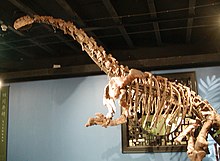Jingshanosaurus
| Jingshanosaurus Temporal range: Early Jurassic
| |
|---|---|

| |
| Skeleton of Jingshanosaurus xinwaensis at the Miami Science Museum. | |
| Scientific classification | |
| Domain: | Eukaryota |
| Kingdom: | Animalia |
| Phylum: | Chordata |
| Clade: | Dinosauria |
| Clade: | Saurischia |
| Clade: | †Sauropodomorpha |
| Clade: | †Sauropodiformes |
| Genus: | †Jingshanosaurus Zhang and Yang, 1995 |
| Type species | |
| †Jingshanosaurus xinwaensis Zhang and Yang, 1995
| |
Jingshanosaurus (meaning "Jingshan lizard") is a genus of sauropodomorph dinosaurs from the early Jurassic period 201.3 million years ago that went extinct 199.3 million years ago in the Hettangian Age.
Its maximum weight was around 4.3 t with an adult femur length of 845 mm.[1] Jingshanosaurus xinwaensis grew to be 5 meters (16.4 ft) long.[2]
History of discovery

Its fossils, a nearly complete skeleton including the skull, were found near the town of Jingshan ("Golden Hill"), Lufeng County, Yunnan Province, China, from which the name derives.[3] First described in 1995, the type species is J. xinwaensis, formalized by Zhang and Yang.[4] Fossil remains of Jingshanosaurus had been exhibited in museums several years prior to the formal naming. A complete skeleton and skull of Jingshanosaurus xinwaensis have been found and is considered the last prosauropods to live on earth.[5]
Classification
Jingshanosaurus may have been most closely related to Yunnanosaurus, and has, at times, been included in the Yunnanosauridae. In fact, Dong Zhiming considered Jingshanosaurus possibly a large specimen of Yunnanosaurus. If true, this would make Jingshanosaurus a junior synonym of Yunnanosaurus.
References
- ^ "Jingshanosaurus xinwaensis Zhang & Yang 1994 data - Encyclopedia of Life". eol.org. Retrieved 2021-12-14.
- ^ "Jingshanosaurus | Natural History Museum". www.nhm.ac.uk. Retrieved 2021-12-14.
- ^ Ben Creisler, Dinosauria Translation and Pronunciation Guide.
- ^ Y. Zhang, and Z. Yang. (1995). A new complete osteology of Prosauropoda in Lufeng Basin, Yunnan, China. Yunnan Publishing House of Science and Technology, Kunming, China 1-100. [Chinese]
- ^ "Jingshanosaurus | Natural History Museum". www.nhm.ac.uk. Retrieved 2021-12-14.












